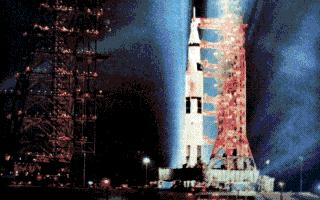Saturn V Rocket

Saturn V Launch
Saturn is a family of large rockets developed for the U.S. Apollo program. The Saturn rocket was the outcome of studies begun in the late 1950s by Wernher von Braun and his research group at the Army Ballistic Missile Agency in Huntsville, Alabama. Saturn I was used to fly engineering models of the Apollo spacecraft.

Saturn V in the Air
Saturn IB was developed to fly heavier payloads for the Apollo program and the Skylab program up to 1975.

Humans reach the Moon July 20, 1969
The Saturn V rocket was 111 meters tall. It weighed 2.9 million kilograms. It was said to carry as much energy as a small atomic bomb. But these rockets had a good safety record: 13 launched without a loss.

Six Apollo missions reached the Moon
The visits to the Moon included 3 lunar rovers, scientific instruments and brought many rock and soil samples back. The last visit was in 1972. We have not been back since.

Apollo 13 Near Disaster
An oxygen tank exploded in the service module not only making a Moon landing impossible, but nearly causing the astronauts of Apollo 13 to die from lack of oxygen and too much carbon dioxide. Luckily they were able to breathe oxygen from the lunar lander. They also used electrical power and rocket propulsion from the lunar lander. They were able to devise a contraption to absorb carbon dioxide.
Back to Rocket Museum